Flexible Transient Resistive Memory Based on Biodegradable Composites
Abstract
1. Introduction
2. Materials and Methods
2.1. Preparation of the Device
2.2. Characteristic Test
3. Results
4. Conclusions
Author Contributions
Funding
Data Availability Statement
Conflicts of Interest
References
- Tominov, R.V.; Vakulov, Z.E.; Polupanov, N.V.; Saenko, A.V.; Avilov, V.I.; Ageev, O.A.; Smirnov, V.A. Nanoscale-Resistive Switching in Forming-Free Zinc Oxide Memristive Structures. Nanomaterials 2022, 12, 455. [Google Scholar] [CrossRef]
- Zoeteman, B.C.J.; Krikke, H.R.; Venselaar, J. Handling WEEE Waste Flows: On the Effectiveness of Producer Responsibility in a Globalizing World. Int. J. Adv. Manuf. Technol. 2010, 47, 415–436. [Google Scholar] [CrossRef]
- Lei, T.; Guan, M.; Liu, J.; Lin, H.C.; Pfattner, R.; Shaw, L.; McGuire, A.F.; Huang, T.C.; Shao, L.L.; Cheng, K.T.; et al. Biocompatible and Totally Disintegrable Semiconducting Polymer for Ultrathin and Ultralightweight Transient Electronics. Proc. Natl. Acad. Sci. USA 2017, 114, 5107–5112. [Google Scholar] [CrossRef] [PubMed]
- Fu, K.K.; Wang, Z.Y.; Dai, J.Q.; Carter, M.; Hu, L.B. Transient Electronics: Materials and Devices. Chem. Mater. 2016, 28, 3527–3539. [Google Scholar] [CrossRef]
- Hwang, S.W.; Song, J.K.; Huang, X.; Cheng, H.Y.; Kang, S.K.; Kim, B.H.; Kim, J.H.; Yu, S.; Huang, Y.G.; Rogers, J.A. High-Performance Biodegradable/Transient Electronics on Biodegradable Polymers. Adv. Mater. 2014, 26, 3905–3911. [Google Scholar] [CrossRef] [PubMed]
- Wang, H.; Zhu, B.W.; Ma, X.H.; Hao, Y.; Chen, X.D. Physically Transient Resistive Switching Memory Based on Silk Protein. Small 2016, 12, 2715–2719. [Google Scholar] [CrossRef] [PubMed]
- Wu, S.W.; Wang, H.; Sun, J.; Song, F.; Wang, Z.; Yang, M.; Xi, H.; Xie, Y.; Gao, H.X.; Ma, J.G.; et al. Dissolvable and Biodegradable Resistive Switching Memory Based on Magnesium Oxide. IEEE Electron Device Lett. 2016, 37, 990–993. [Google Scholar] [CrossRef]
- Waser, R.; Aono, M. Nanoionics-based Resistive Switching Memories. Nat. Mater. 2007, 6, 833–840. [Google Scholar] [CrossRef]
- Kwon, D.H.; Kim, K.M.; Jang, J.H.; Jeon, J.M.; Lee, M.H.; Kim, G.H.; Li, X.S.; Park, G.S.; Lee, B.; Han, S.; et al. Atomic structure of Conducting Nanofilaments in TiO2 Resistive Switching Memory. Nat. Nanotechnol. 2010, 5, 148–153. [Google Scholar] [CrossRef]
- Wang, X.F.; Tian, H.; Zhao, H.M.; Zhang, T.Y.; Mao, W.Q.; Qiao, Y.C.; Pang, Y.; Li, Y.X.; Yang, Y.; Ren, T.L. Interface Engineering with MoS2-Pd Nanoparticles Hybrid Structure for a Low Voltage Resistive Switching Memory. Small 2018, 14, 1702525. [Google Scholar] [CrossRef] [PubMed]
- Waser, R.; Dittmann, R.; Staikov, G.; Szot, K. Redox-Based Resistive Switching Memories—Nanoionic Mechanisms, Prospects, and Challenges. Adv. Mater. 2009, 21, 2632–2663. [Google Scholar] [CrossRef]
- Yang, Y.C.; Gao, P.; Gaba, S.; Chang, T.; Pan, X.Q.; Lu, W. Observation of Conducting Filament Growth in Nanoscale Resistive Memories. Nat. Commun. 2012, 3, 732. [Google Scholar] [CrossRef]
- Schmidt, D.O.; Raab, N.; Noyong, M.; Santhanam, V.; Dittmann, R.; Simon, U. Resistive Switching of Sub-10 nm TiO2 Nanoparticle Self-Assembled Monolayers. Nanomaterials 2017, 7, 370. [Google Scholar] [CrossRef]
- Ge, L.P.; Xuan, W.P.; Liu, S.T.; Huang, S.Y.; Wang, X.Z.; Dong, S.R.; Jin, H.; Luo, J.K. Biomaterial Gelatin Film Based Crossbar Structure Resistive Switching Devices. IEEE Trans. Nanotechnol. 2018, 17, 78–83. [Google Scholar] [CrossRef]
- Chang, Y.C.; Jian, J.C.; Hsu, Y.L.; Huang, W.Y.; Young, S.J. A Green Strategy for Developing a Self-Healing Gelatin Resistive Memory Device. ACS Appl. Polym. Mater. 2020, 2, 5318–5326. [Google Scholar] [CrossRef]
- Raeis-Hosseini, N.; Lee, J.S. Controlling the Resistive Switching Behavior in Starch-Based Flexible Biomemristors. ACS Appl. Mater. Interfaces 2016, 8, 7326–7332. [Google Scholar] [CrossRef] [PubMed]
- Xu, X.J.; Zhou, X.F.; Wang, T.Y.; Shi, X.; Liu, Y.; Zuo, Y.; Xu, L.M.; Wang, M.Y.; Hu, X.F.; Yang, X.J.; et al. Robust DNA-Bridged Memristor for Textile Chips. Angew. Chem. Int. Ed. 2020, 59, 12762–12768. [Google Scholar] [CrossRef] [PubMed]
- Abbas, Y.; Dugasani, S.R.; Raza, M.T.; Jeon, Y.R.; Park, S.H.; Choi, C. The Observation of Resistive Switching Characteristics Using Transparent and Biocompatible Cu2+-doped Salmon DNA Composite Thin Film. Nanotechnology 2019, 30, 335203. [Google Scholar] [CrossRef] [PubMed]
- Zhang, C.C.; Shang, J.; Xue, W.H.; Tan, H.W.; Pan, L.; Yang, X.; Guo, S.S.; Hao, J.; Liu, G.; Li, R.W. Convertible Resistive Switching Characteristics Between Memory Switching and Threshold Switching in a Single Ferritin-based Memristor. Chem. Commun. 2016, 52, 4828–4831. [Google Scholar] [CrossRef]
- Ko, Y.; Kim, Y.; Baek, H.; Cho, J. Electrically Bistable Properties of Layer-by-Layer Assembled Multilayers Based on Protein Nanoparticles. ACS Nano 2011, 5, 9918–9926. [Google Scholar] [CrossRef]
- Hosseini, N.R.; Lee, J.S. Resistive Switching Memory Based on Bioinspired Natural Solid Polymer Electrolytes. ACS Nano 2015, 9, 419–426. [Google Scholar] [CrossRef]
- Hosseini, N.R.; Lee, J.S. Biocompatible and Flexible Chitosan-Based Resistive Switching Memory with Magnesium Electrodes. Adv. Funct. Mater. 2015, 25, 5586–5592. [Google Scholar] [CrossRef]
- Chen, Y.S.; Hong, M.Y.; Huang, G.S. A Protein Transistor Made of an Antibody Molecule and Two Gold Nanoparticles. Nat. Nanotechnol. 2012, 7, 197–203. [Google Scholar] [CrossRef] [PubMed]
- de la Rica, R.; Matsui, H. Applications of Peptide and Protein-based Materials in Bionanotechnology. Chem. Soc. Rev. 2010, 39, 3499–3509. [Google Scholar] [CrossRef] [PubMed]
- Hota, M.K.; Bera, M.K.; Kundu, B.; Kundu, S.C.; Maiti, C.K. A Natural Silk Fibroin Protein-Based Transparent Bio-Memristor. Adv. Funct. Mater. 2012, 22, 4493–4499. [Google Scholar] [CrossRef]
- Wang, H.; Meng, F.B.; Cai, Y.R.; Zheng, L.Y.; Li, Y.G.; Liu, Y.J.; Jiang, Y.Y.; Wang, X.T.; Chen, X.D. Sericin for Resistance Switching Device with Multilevel Nonvolatile Memory. Adv. Mater. 2013, 25, 5498–5503. [Google Scholar] [CrossRef] [PubMed]
- Chen, Y.C.; Yu, H.C.; Huang, C.Y.; Chung, W.L.; Wu, S.L.; Su, Y.K. Nonvolatile Bio-Memristor Fabricated with Egg Albumen Film. Sci. Rep. 2015, 5, 10022. [Google Scholar] [CrossRef]
- Chang, J.W.; Wang, C.G.; Huang, C.Y.; Tsai, T.D.; Guo, T.F.; Wen, T.C. Chicken Albumen Dielectrics in Organic Field-Effect Transistors. Adv. Mater. 2011, 23, 4077–4081. [Google Scholar] [CrossRef] [PubMed]
- Chen, I.T.; Chang, P.H.; Chang, Y.C.; Guo, T.F. Lighting Up Ultraviolet Fluorescence from Chicken Albumen Through Plasmon Resonance Energy Transfer of Gold Nanoparticles. Sci. Rep. 2013, 3, 1505. [Google Scholar] [CrossRef] [PubMed]
- He, X.L.; Zhang, J.; Wang, W.B.; Xuan, W.P.; Wang, X.Z.; Zhang, Q.L.; Smith, C.G.; Luo, J.K. Transient Resistive Switching Devices Made from Egg Albumen Dielectrics and Dissolvable Electrodes. ACS Appl. Mater. Interfaces 2016, 8, 10954–10960. [Google Scholar] [CrossRef] [PubMed]
- Roldan, J.B.; Gonzalez-Cordero, G.; Picos, R.; Miranda, E.; Palumbo, F.; Jimenez-Molinos, F.; Moreno, E.; Maldonado, D.; Baldoma, S.B.; Al Chawa, M.M.; et al. On the Thermal Models for Resistive Random Access Memory Circuit Simulation. Nanomaterials 2021, 11, 1261. [Google Scholar] [CrossRef]
- Jafari, A.; Ghoranneviss, M.; Gholami, M.; Elahi, A.S.; Ghafi, A.K. The Effects of Percent and Position of Nitrogen Atoms on Electronic and Thermoelectric Properties of Graphene Nanoribbons. J. Inorg. Organomet. Polym. Mater. 2016, 26, 1095–1100. [Google Scholar] [CrossRef]
- Kazanskiy, N.L.; Butt, M.A.; Khonina, S.N. Optical Computing: Status and Perspectives. Nanomaterials 2022, 12, 2171. [Google Scholar] [CrossRef]
- Bokare, A.; Arif, J.; Erogbogbo, F. Strategies for Incorporating Graphene Oxides and Quantum Dots into Photoresponsive Azobenzenes for Photonics and Thermal Applications. Nanomaterials 2021, 11, 2211. [Google Scholar] [CrossRef]
- Li, F.S.; Kou, L.J.; Chen, W.; Wu, C.X.; Guo, T.L. Enhancing the Short-circuit Current and Power Conversion Efficiency of Polymer Solar Cells with Graphene Quantum Dots Derived from Double-walled Carbon nanotubes. NPG Asia Mater. 2013, 5, e60. [Google Scholar] [CrossRef]
- Shen, J.H.; Zhu, Y.H.; Yang, X.L.; Li, C.Z. Graphene Quantum Dots: Emergent Nanolights for Bioimaging, Sensors, Catalysis and Photovoltaic Devices. Chem. Commun. 2012, 48, 3686–3699. [Google Scholar] [CrossRef]
- Ooi, P.C.; Lin, J.; Kim, T.W.; Li, F.S. Tristable Switching of the Electrical Conductivity Through Graphene Quantum Dots Sandwiched in Multi-stacked Poly(Methyl Methacrylate) Layers. Org. Electron. 2016, 38, 379–383. [Google Scholar] [CrossRef]
- Zhou, G.D.; Sun, B.; Hu, X.F.; Sun, L.F.; Zou, Z.; Xiao, B.; Qiu, W.K.; Wu, B.; Li, J.; Han, J.J.; et al. Negative Photoconductance Effect: An Extension Function of the TiOx-Based Memristor. Adv. Sci. 2021, 8, 2003765. [Google Scholar] [CrossRef]
- Wang, L.; Yang, J.; Zhang, Y.K.; Wen, D.Z. Dual-Tunable Memristor Based on Carbon Nanotubes and Graphene Quantum Dots. Nanomaterials 2021, 11, 2043. [Google Scholar] [CrossRef]
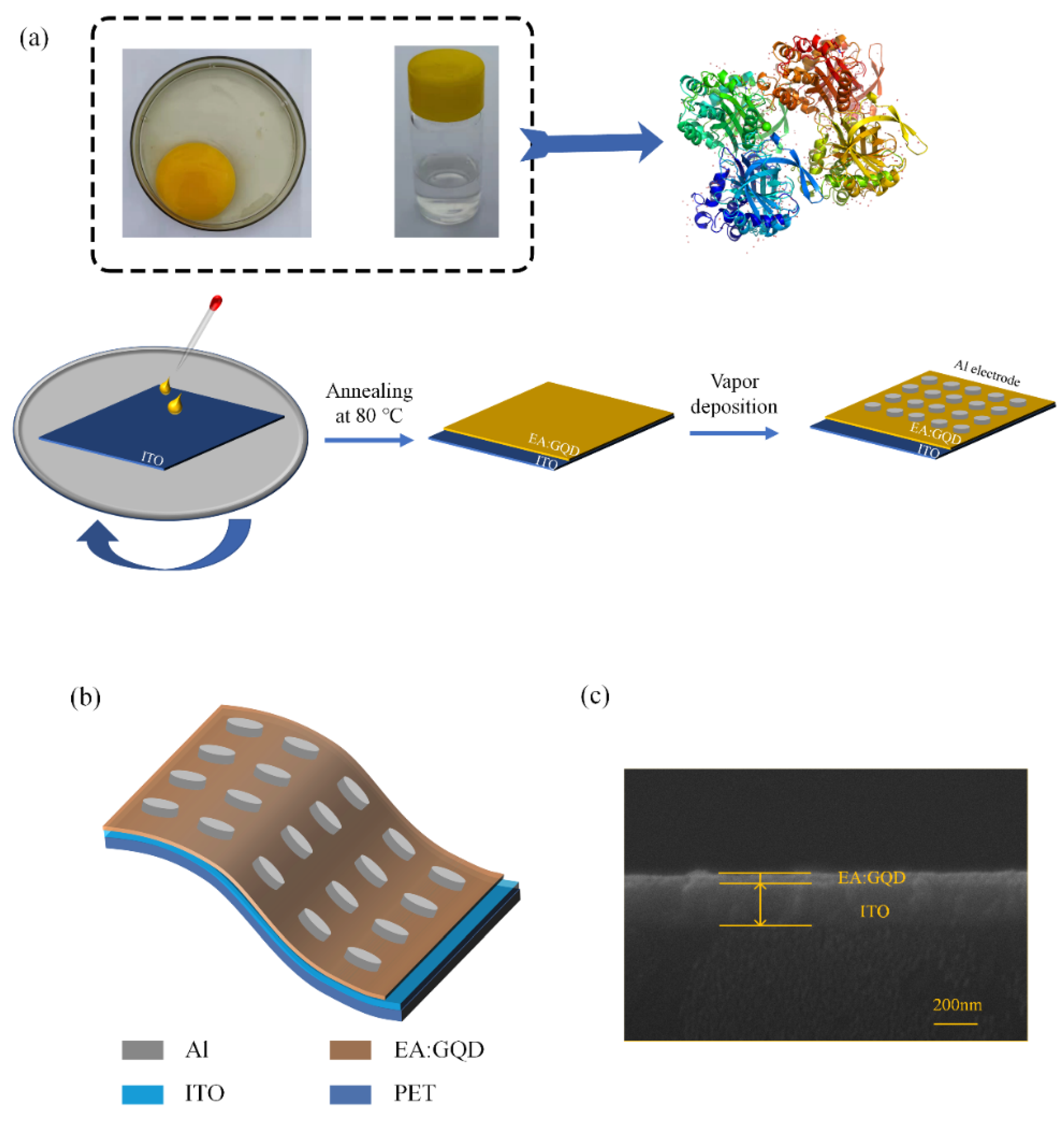
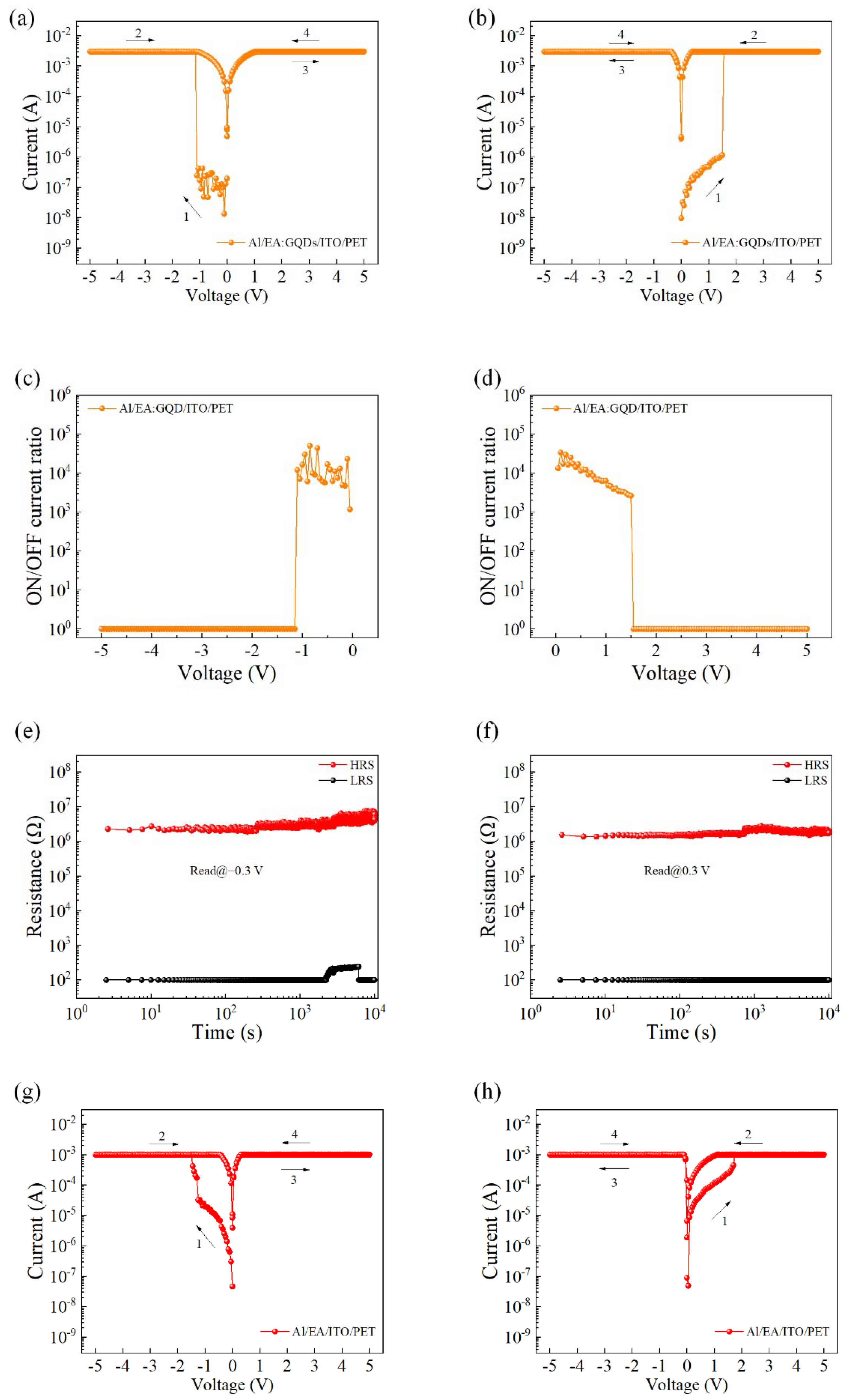
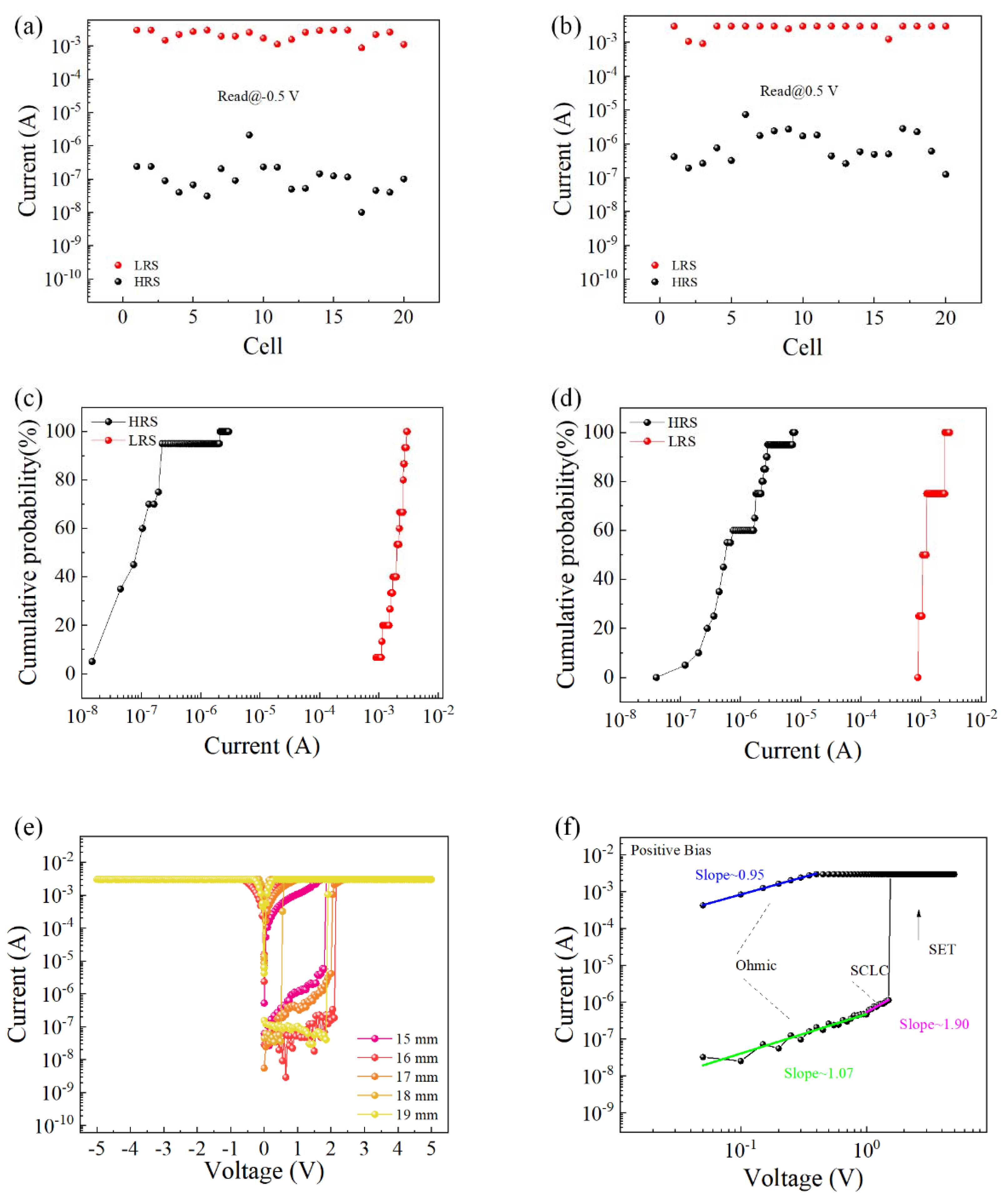
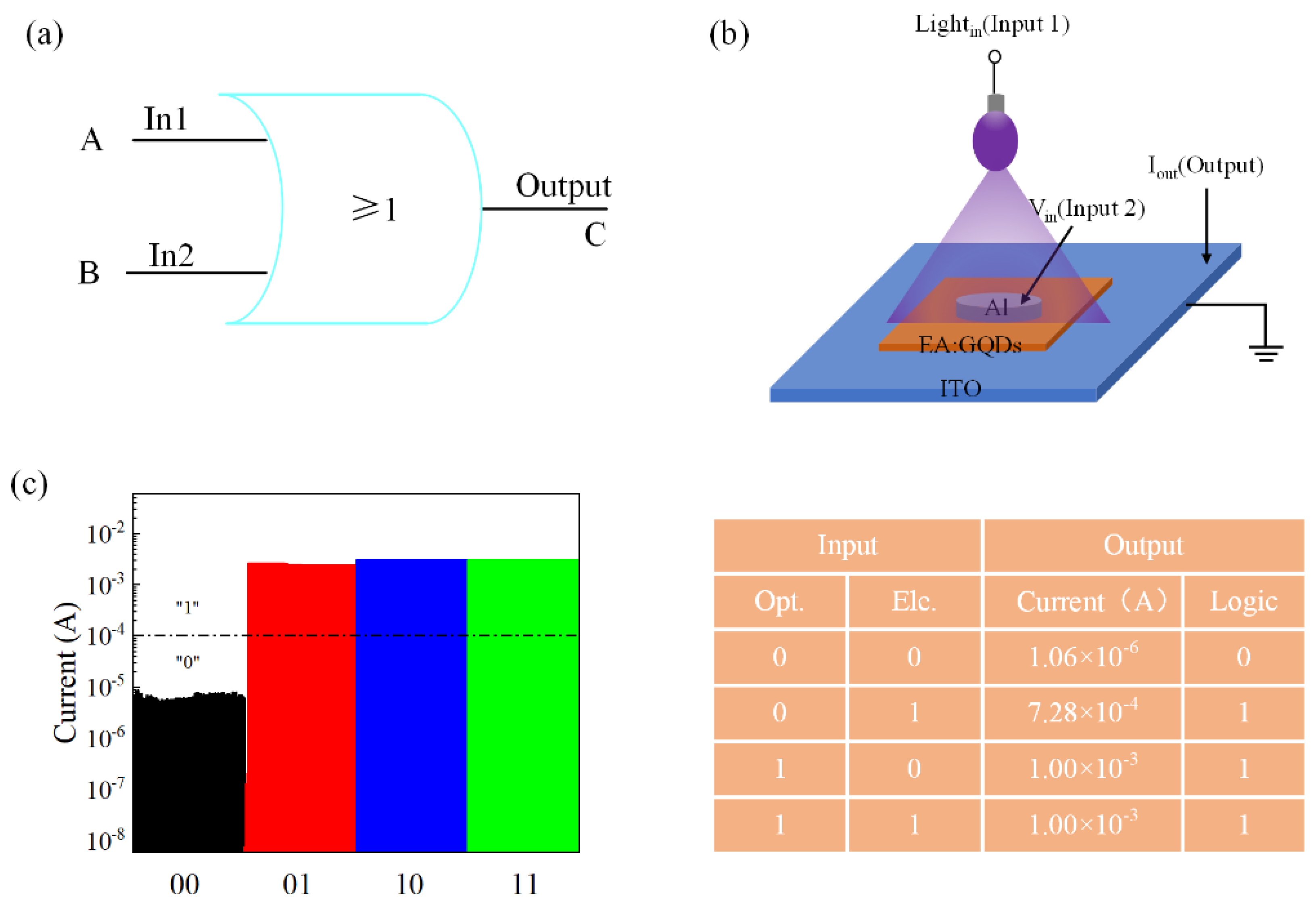

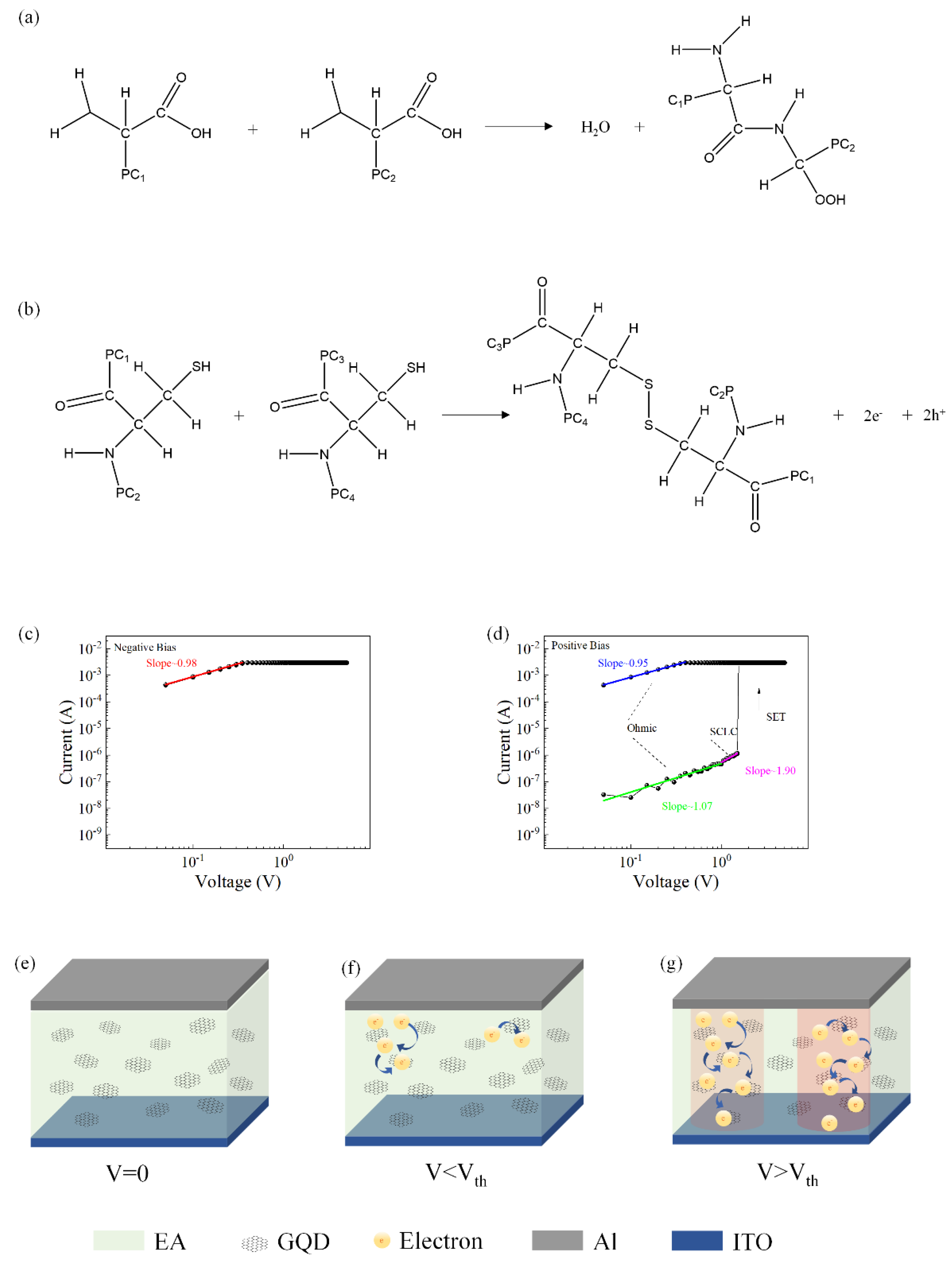
Publisher’s Note: MDPI stays neutral with regard to jurisdictional claims in published maps and institutional affiliations. |
© 2022 by the authors. Licensee MDPI, Basel, Switzerland. This article is an open access article distributed under the terms and conditions of the Creative Commons Attribution (CC BY) license (https://creativecommons.org/licenses/by/4.0/).
Share and Cite
Wang, L.; Zhang, Y.; Zhang, P.; Wen, D. Flexible Transient Resistive Memory Based on Biodegradable Composites. Nanomaterials 2022, 12, 3531. https://doi.org/10.3390/nano12193531
Wang L, Zhang Y, Zhang P, Wen D. Flexible Transient Resistive Memory Based on Biodegradable Composites. Nanomaterials. 2022; 12(19):3531. https://doi.org/10.3390/nano12193531
Chicago/Turabian StyleWang, Lu, Yukai Zhang, Peng Zhang, and Dianzhong Wen. 2022. "Flexible Transient Resistive Memory Based on Biodegradable Composites" Nanomaterials 12, no. 19: 3531. https://doi.org/10.3390/nano12193531
APA StyleWang, L., Zhang, Y., Zhang, P., & Wen, D. (2022). Flexible Transient Resistive Memory Based on Biodegradable Composites. Nanomaterials, 12(19), 3531. https://doi.org/10.3390/nano12193531





